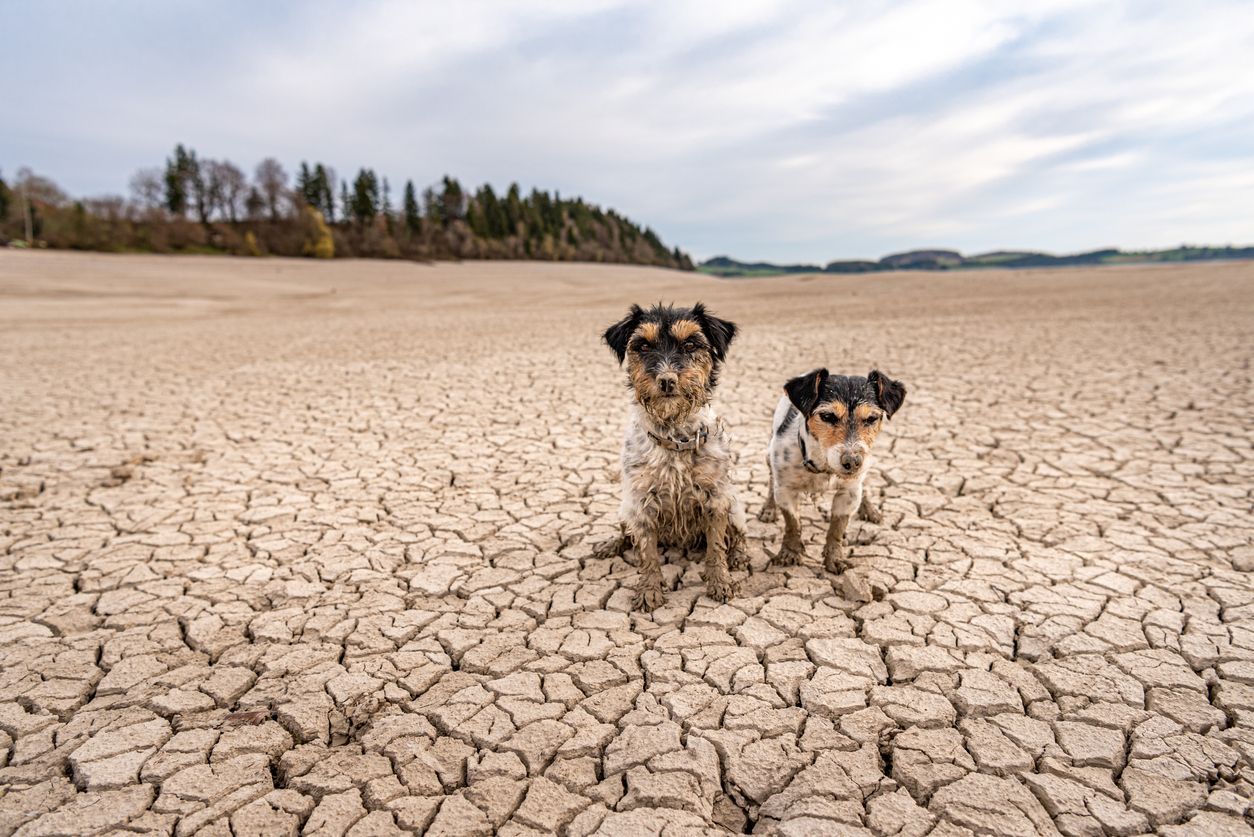Can a nutritional deficiency cause my dog’s paws to be dry and cracked?

Good nutrition is important for all parts of a dog’s body, including their paw pads and skin. Certain nutrients are important for maintaining healthy paw pads. When a dog has a nutritional deficiency due to a health issue or poor diet, they can develop dry, scaly, cracked paw pads as well as other skin and health problems. If your dog has poor paw health, read on to learn:
- Potential causes of cracked paw pads in dogs
- How nutritional deficiencies can affect paw health in dogs
- Diagnosis and medical treatment for paw pad issues in dogs
Cracked paw pads are more commonly caused by something other than a nutritional deficiency. Injuries (such as walking on hot pavement or rough surfaces), skin conditions (such as allergies), and exposure to chemicals or irritants are more likely causes than a nutrient deficiency. Even if a dog’s cracked paw pads are due to a nutritional deficiency, their diet may not be the underlying issue. Many health issues can lead to nutritional deficiencies by limiting the absorption or utilization of a nutrient. Essential fatty acid, vitamin A, and zinc deficiencies can all affect a dog’s paw health.
What does it mean when a dog’s paw pads are cracked?
Various health issues can lead to dry, scaly, rough, thick, excessively hard, or cracked paw pads. These include:
- Injuries, such as abrasions, punctures, and burns from hot surfaces or due to exposure to irritants and chemicals
- Environmental or food allergies
- Canine distemper
- Endocrine disorders, such as hypothyroidism and Cushing’s disease
- Autoimmune diseases, such as pemphigus
- Liver disease (hepatocutaneous syndrome)
- Nutritional deficiencies
In addition to health conditions causing paw pad changes, certain dog breeds are predisposed to hereditary paw pad issues.
Cracked paw pads are at risk of infection. In addition, overly thick, hard, or cracked paw pads can be uncomfortable or painful for dogs. “Nutrition plays a role in a dog’s paw health,” explains Dr. Jo Myers, a veterinarian on the Vetster platform. “However, nutritional deficiencies are uncommon in dogs overall and not a common cause for paw pad problems. Other medical conditions are much more common in comparison.”
What is a nutritional deficiency?
A nutritional deficiency occurs when a lack of an essential nutrient disrupts the body to the extent that the dog’s health is affected. Nutrient deficiencies are usually caused by an underlying health issue rather than a problem with the dog’s food. Some medical issues cause an essential nutrient to be poorly absorbed, ineffectively used, or increasingly lost. Less commonly, deficiencies are caused by a lack of sufficient nutrients in the diet or not eating enough food to meet nutritional requirements.
Nutrient deficiencies are rare in otherwise healthy dogs who consume commercial dog foods with the Association of American Feed Control Officials (AAFCO) statement of nutritional adequacy on the label. These diets are formulated to meet nutritional standards, ensuring they contain the right amount of essential nutrients for the majority of healthy dogs. Nutritional deficiencies are more likely in dogs who:
- Eat mostly treats, table scraps, and other snacks
- Are given home-cooked diets made without the guidance of a veterinary nutritionist
- Are fed primarily a commercial food that does not have an AAFCO statement of nutritional adequacy on the label
If a food is labeled as a supplement, topper, snack, treat, mixer, or base, that usually means it isn’t intended for use as a complete diet, so it’s unlikely to be formulated to meet AAFCO standards. This may include some boutique, exotic, or premium-brand foods. While these options may seem like a step up in quality, they aren’t always formulated to meet a dog’s complete nutritional needs. Always check the label to ensure the food is balanced and appropriate for long-term feeding.
Nutritional diseases that can affect a dog’s paw pad health
Though other causes are more likely, dry, cracked, or rough paws in dogs can be a result of a deficiency in:
- Zinc
- Vitamin A
- Fatty acids
An inadequate amount of these nutrients can result in paw pad hyperkeratosis, or overly thickened paw pads that can crack. Nutritional deficiencies usually affect more than just the paw pads, so if the issue is due to a deficiency, a dog may also show:
- Scaly or inflamed skin in places other than the paw pads
- Poor coat quality
- Secondary infections
- General signs of systemic illness
Zinc is essential for protein synthesis and cellular replication, both of which are important for skin health. Dogs with zinc-responsive dermatosis may have skin lesions, hair loss, and overly thick paw pads that can crack.
Vitamin A deficiency can affect a dog’s skin, eyes, immune system, and reproductive health. Vitamin A is essential for maintaining healthy skin and a strong immune system, so deficiency can impair the integrity of the skin barrier and reduce immune function, which in turn may increase the risk of secondary skin infections.
Essential fatty acids (EFAs) are an important component of healthy cell membranes that prevent water loss through the skin and help modulate inflammation. Dogs with EFA deficiencies may have scaly skin, including on the paws, and a poor coat condition. EFAs help keep skin cells healthy and provide a protective layer against microbes, allergens, and other molecules that can cause skin issues.
How paw pad issues are diagnosed and treated
When a dog presents with thick, cracked, or scaly paw pads, a veterinarian may recommend diagnostic tests to determine the underlying cause. Tests may include:
- Physical exam
- Nutritional history
- Examination of skin and hair under a microscope (cytology)
- Blood tests
Treatment options depend on the underlying cause of the symptoms. The majority of cases are caused by an underlying health issue rather than a nutritional deficiency. In cases where poor paw health is caused by a nutritional deficiency, treatment may involve:
- Treating health issues causing the deficiency
- Change in diet
- Dietary supplementation
Symptomatic care may be recommended to soothe paw irritation or pain while the deficiency is being treated. This may include using topical ointments and making environmental changes, such as keeping the dog on carpet as opposed to rough dirt or gravel. If the underlying issue causing the nutritional deficiency is not addressed, the paw problems are likely to continue, even with paw pad care. Cracked paw pads usually require more care than simply adding a nutritional supplement or treating the paw pad.
Can I treat my dog’s cracked paw pads at home?
There are a lot of home remedies that claim to help a dog’s cracked, dry paw pads, such as:
- Coconut oil
- Human skin care products
- Petroleum jelly or lotion
However, these do not address the actual problem and are not effective treatment options. While coconut oil and petroleum jelly can help temporarily moisturize paw pads, they do not address the underlying cause. Overly thick, cracked, or dry paw pads are usually due to an injury or underlying health issue. Without addressing the underlying problem, these products won’t help much. In addition, human skin care products may have ingredients that are toxic to dogs, such as essential oils, zinc oxide, and various fragrances, and dogs are likely to lick off whatever product is put on their paws.
Attempting home treatments before talking to a vet delays proper care, allowing the underlying problem to continue and possibly get worse. While the underlying condition is being treated, supportive care at home is best given under the supervision of a veterinarian to ensure it’s safe and effective. Virtual vet appointments are an excellent way to talk to a vet about your dog’s symptoms and about how to make your dog more comfortable.
What to do if your dog has paw pad cracks or dryness
Dry, rough, or cracked paw pads can be a sign that something is wrong, even if your dog seems otherwise healthy. Poor paw health is more likely to be caused by an injury, external irritants, or a medical issue than a nutritional deficiency. It’s best for pet owners to talk to a veterinarian anytime they notice changes to their dog’s physical health and appearance, including to their paw pads. If you’re unsure if your dog’s paw pads are healthy, an online vet is available to look at them and discuss your dog’s medical and dietary history to provide guidance on what to do next.
FAQ - Can a nutritional deficiency cause my dog’s paws to be dry and cracked?
How do you treat dry, cracked dog paws?
Treatment for dry, cracked paws depends on the underlying cause. Poor paw health in dogs is usually caused by an injury, exposure to external irritants, or an underlying health issue. It’s important to talk to a vet if you notice changes in your dog’s paw health to get an accurate diagnosis and to discover what kind of treatment is indicated. It’s best not to use coconut oil, petroleum jelly, or other home remedies to soothe irritated paw pads unless directed to do so by a veterinarian. These treatment methods do not address the primary problem and are unlikely to provide a complete solution, and some may even be harmful.
What does a cracked paw pad in dogs look like?
If your dog’s paw pads are cracked, they may be overly thick, rough, or scaly, with cracks or open wounds on them, and your dog may lick them excessively. Overly thick, hard, or scaly paw pads are more likely to crack, and cracked paw pads are susceptible to secondary infections, which may cause additional symptoms, such as redness, swelling, drainage, and odor. Talk to a vet if you notice your dog’s paw health is poor, even if they seem otherwise healthy.
Can a dog’s diet affect their paw pads?
Though uncommon, deficiencies in essential nutrients such as zinc, fatty acids, and vitamin A can result in poor paw pad health. To ensure your dog is eating a balanced diet, look for the AAFCO statement of nutritional adequacy on the food’s label.
Disclaimer: This article, its content, and its related references do not constitute veterinary advice and should not be considered a substitute for veterinary care. If your pet is showing any symptoms that could indicate a medical emergency, please seek immediate emergency care.




